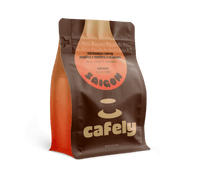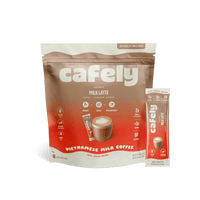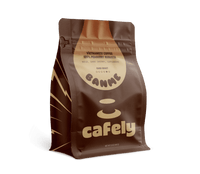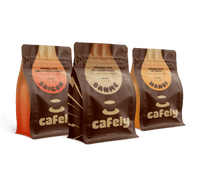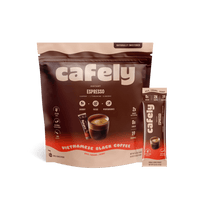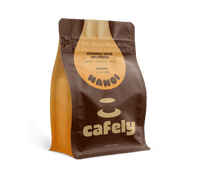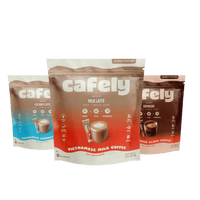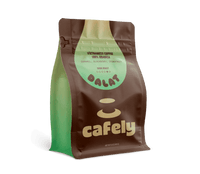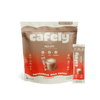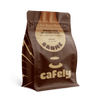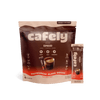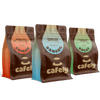Thinking about joining the "60% of the world that drinks coffee every day? "
From health benefits to a warm treat to look forward to every morning, coffee has a lot to offer [1]. Coffee’s crisp and clear rush fuels most of the world and tastes great while doing it.
Don’t let complex brewing methods, fancy drinks, and artisanal beans scare you off — just read our beginner's coffee guide and fast-track to enjoying your first cup.
Best Coffee for Your Current Energy Drink Preference
Your favorite beverages can guide you to the perfect coffee match. Different drinkers will naturally gravitate toward different coffee styles that complement their established taste preferences:
- Tea Drinkers: Try light roast pour-overs or Ethiopian beans with floral notes; add honey as you might with tea
- Energy Drink Enthusiasts: Seek highly-caffeinated light roasts or iced coffee with flavor shots for familiar sweetness and buzz
- Soda Drinkers: Explore nitro cold brew for its creamy fizz-like texture or coffee tonics (espresso with tonic water) for actual carbonation
- Non-Drinkers: Start with half-caf or flavored lattes where familiar chocolate or vanilla flavors mask the coffee intensity
Tips for First-Time Coffee Drinkers
Getting into coffee isn’t rocket science, but there are a few things to keep in mind to have the best experience as a beginner.
- Consider the caffeine — Coffee (or rather the caffeine in it) will give you a buzz, so be prepared! Everyone reacts a bit differently, so take it easy and start with a single, small cup [3].
- Ease into coffee’s flavor — If you’re new to coffee, it might take some time to acquire the taste. Start with coffee-flavored foods or drinks to get familiar.
- Balance the bitterness — Add cream and sugar to soften the strong flavor. Non-dairy options like almond or oat milk work well, too.
- Perfect your brew — Brewing a good cup takes practice. Beginners often make it too strong or too weak. Follow our numerous brew guides to improve your technique.
- Avoid an empty stomach — Drinking coffee on an empty stomach can cause discomfort. Try having it after eating if it doesn’t sit well first thing in the morning [4].
- Sip slowly — Sip your coffee instead of chugging it. Drinking too fast can cause a caffeine rush and jitters.
How to Order Coffee in a Café

Finding a local coffee shop is the easiest way to get a good first cup of coffee. The options and names of drinks come from Italy and mostly refer to different amounts of coffee and milk.
Here are the most popular cafe drinks to get you started:
1. Ordering Drip Coffee
Drip coffee is a straight, no-nonsense cup like folks order in diners in movies. Sometimes called “filter coffee,” it’s an easy place to start. We recommend some cream and sugar to take the edge off.
2. Ordering Espresso
Espresso coffee is coffee brewed under pressure in a special machine that makes strong, flavorful shots quickly. We don’t recommend getting espresso on your first try because the flavor is pretty intense, and the caffeine rush can be a lot for new people.
3. Ordering A Latte
A café latte is a combination of a shot of espresso and steamed milk. Creamy with a little bit of foam, lattes are two parts milk and one part espresso. Think softer coffee flavor and a great place to start for beginners. If you want an extra blast of flavor (and sweetness) try adding some syrup like caramel or hazelnut.
4. Ordering A Cappuccino
A cappuccino coffee is similar to a latte but with more foam and less milk. If you want a bit more coffee flavor and love the silky texture of lots of foam, try a cappuccino. The ratio is around one part coffee, one part milk, and one part foam.
5. Ordering An Americano
If milk isn't your thing and you want to get to know the coffee flavor, try an Americano coffee. An Americano is a shot (or more) of espresso diluted with hot water. The espresso flavor remains strong but without the thickness of milk, much more when you use the best espresso selections.
If you want a taste of espresso, this drink is a great option. Your barista may ask you if you want “room”, which means not filling the cup to leave space for cream or milk, which is not a bad idea for your first Americano.
6. Ordering An Iced Coffee
Coffee doesn't have to be piping hot. Drip coffee poured over ice can be both refreshing and energizing. As the ice melts, it can water down the coffee, while milk and sugar can make things smoother and sweeter, if you like.
Iced coffees and a cup of Frappuccino are also great to buy at cafes and chains for a sweet treat.
Which Type of Coffee is Best for Non-Coffee Drinkers?
Choosing the right coffee will make a difference when you first start drinking it. There are two common types of coffee to choose from, along with many different roasts.
For the absolute beginner, a medium roast arabica is a good place to start. We recommend the 100% arabica DaLat for a smooth and somewhat sweet first experience.
Different Coffee Beans for Beginners

Pay attention when buying a bag of coffee because the type of beans and their roast level will change the caffeine content and flavors.
When you're just starting out, we recommend going for less intense flavors and lower caffeine content:
- Arabica coffee — This is the most common type of coffee and is a fine place to start for new drinkers. The flavors are milder, sweeter, and smoother, while the caffeine content is a bit less.
- Robusta coffee — A rarer bean, but growing in popularity. Beans like the Peaberry variety are the favorite of experienced coffee drinkers who are looking for a bolder flavor and who enjoy higher caffeine content.
- Blends — These combine both arabica and robusta beans to create new and more complex flavors. Trying different blends is a nice way to transition between arabica and robusta or to simply unlock new flavors.
Best Coffee Roast for Non-Coffee Drinkers
For the new coffee drinker, it's best to avoid extremes until you understand what you want from your cup of coffee. Coffee is roasted on a spectrum, starting to light and going up to dark.
Pay attention to roast because these variables change how much caffeine is in each cup, along with altering the flavors.
Light Roast Coffee
A light roast is a coffee roasted for the shortest amount of time. The beans are lighter in color, and this method can preserve more natural flavors.
Light roasts will usually have a higher caffeine content but can be a bit more acidic. A light roast might be a bit intense for beginners but is also an excellent introduction to the flavor coffee can offer. Or just be a good buzz.
Medium Roast Coffee
Roasted longer, with darker beans, less caffeine, and a more muted flavor than light roast.
Medium roast coffee is smoother and easier to drink, although some people prefer more intensity in their cups than medium roasts can provide.
Medium is the middle ground and the easiest place to start for the non-coffee drinker, especially if you are trying black coffee for the first time. We recommend grabbing a bag of DaNang to start the journey.
Dark Roast Coffee
Dark roast coffee beans are roasted for the longest period, making the beans dark and bringing out slightly more bitter tastes but also caramel-like sweetness.
Dark roast also tends to be the least acidic, which is a big plus for many folks sensitive to coffee’s effects.
Our DaLat 100% arabica is a great place for the beginner who likes bitters and is sensitive to caffeine. Adding a bit of milk and sugar can also take the edge off.
The Easiest Ways To Make Coffee
One of the biggest challenges for the new coffee drinker is making a satisfying cup.
Coffee can have a smooth, full-bodied flavor if done right. But if made too strong, it will be bitter, harsh, and cause jitters. Brew it too weakly, and the coffee will be watery and lacking flavor.
Getting a brew right can take some practice, but you don’t need to be a professional barista to make a good cup.
1. Coffee Pods for Beginners
Pre-measured pods used in making coffee with Keurig and Nespresso machines are extremely convenient and come in tons of flavors, along with pre-added sugar and cream for fancy cafe drinks like cappuccinos and lattes.
Most pods function the same way — add water to the machine’s reservoir, place a pod in the space designed for it, place the mug under the spout, and then hit the power button.
2. Making Instant Coffee for Beginners
In our opinion, instant coffee is underrated. Don’t let anyone talk you down from instant coffee until you have tried it because, in the 21st century, it can be very high quality.
Not to mention fast, convenient, and portable. With sachets like Instant Milk Latte, you can always have a quick and delicious blast of caffeine ready.
Making instant coffee is fast and easy — just empty the packet into a cup, add hot water and stir.
3. Drip Coffee for Beginners
The classic coffee. And if you get the grind and ratios right, drip tastes as good as any other option.
The carafe (the coffee pot) will typically have numbers on the side showing how much water to add for how many cups. Either fill the pot up or pour the water into the reservoir in the machine.
Next, place a filter in the machine basket.
Making drip coffee requires a medium grind. You can buy ground coffee at the store, or if you do it yourself, aim for the size of sea salt.
Measure your coffee carefully. Depending on the beans and your tastes, this can take a couple of tries. For every 2 cups of water, put one or two tablespoons of ground coffee in the filter.
Press the on button and wait. The machine should start to make sounds pretty quickly, and you will see coffee drip through the filter into the pot.
4. Aeropress for Beginners
Aeropress brewer is fast and easy to get right. It is loved by beginners and aficionados alike.
While you boil some water, place one or two filters in the base of the Aeropress and screw it together. Then, place the brewer on top of a sturdy mug.
Use the provided scoop to measure your coffee. Use one scoop and water to the fourth line for a regular coffee and two scoops with water filled to the second line.
Stir the grounds and wait about thirty seconds.
Slide the plunger into the Aeropress and, with a smooth, even pressure, push the water through the coffee grounds into your cup for about thirty seconds.
What is Coffee?
Coffee (species in the Coffea genus) are plants originally from Africa [2]. The drink is made from the seeds (commonly called beans) of the plant, which are dried, roasted, and ground.
The most common way to consume coffee is by mixing it with hot water. The resulting drink is dark, rich in flavors, and infused with caffeine — the substance responsible for the energizing buzz many love coffee for.
FAQs: Coffee for Beginners

1. Do I Have to Add Cream and Sugar to Coffee?
Cream and sugar aren’t necessary, and black coffee is the favorite of many people.
If you want to experience the full flavors of black coffee or remove some calories from every cup, you can start to reduce the use of sugar and milk. Take it slow to get used to the bitter flavor.
2. Why Does My Coffee Taste Bitter?
Excessive bitter coffee indicates over-extraction. In simple terms, it was brewed too long or ground too fine, or there wasn’t enough water added.
Sometimes, old beans can become bitter too, so don’t leave them too long.
3. How Should I Store Coffee Beans?
Coffee beans should be stored in an airtight container. Resealable bags are great, and so are jars with a tight seal.
Coffee needs to be kept dry, out of sunlight, and shouldn’t get too hot.
4. Do I Need an Expensive Coffee Maker?
Fancy coffee-brewing devices aren’t necessary. A drip coffee maker, French press, or Aeropress are easy to use and relatively inexpensive.
High-end espresso machines and stylish pour-over devices make incredible cups of coffee, they just take a bit more time to master.
References
- Cano-Marquina, A., Tarín, J. J., & Cano, A. (2013). The impact of coffee on health. Maturitas, 75(1), 7-21.
- Crawford, J. (1852). History of coffee. Journal of the Statistical Society of London, 15(1), 50-58.
- Yang, A., Palmer, A. A., & De Wit, H. (2010). Genetics of caffeine consumption and responses to caffeine. Psychopharmacology, 211, 245-257.
- J. Boekema, M. Samsom, GP van Berge Henegouwen, AJPM Smout, P. (1999). Coffee and gastrointestinal function: facts and fiction: a review. Scandinavian Journal of Gastroenterology, 34(230), 35-39.
